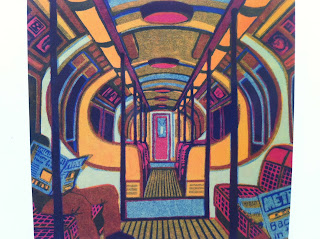
The title of this post is not a reference to myself (!) but the title of a book by David Boyd Haycock about five artists who were fellow students at The Slade before the first war and how the events of the war shaped their work and lives. I read it shortly after returning from France and found it enhanced my understanding of the artistic milieux of that time considerably.
The five artists were, Paul Nash, Stanley Spencer, Mark Gertler, Richard Nevinson and Dora Carrington.
I knew quite a bit about Stanley Spencer and Paul Nash whose work has always interested me but the others were unknown to me. The most interesting thing was how much they all corresponded with each other. I wondered at the impact of the first showings in England of the Post Impressionist work on our Art establishment. It seemed like the five young artists were all cautiously deciding how to respond to these new French ideas and were very conscious of working out whether they were valid or not. There were other art movements, such as the Italian Futurists trying to seduce them from the true path of English art; whatever that was they were all unknowingly defining it.
The book portrayed a country with the masses seeking a greater voice in the wake of industrialisation but the Establishment nevertheless holding onto power to the extent that young men flocked to the call of the recruiting sergeants in their thousands. The acceptance of things as they were meant that new ideas were seen as a threat and this was the same in Art.
The five artists were the brightest talents of their generation, 'Les Jeunnes' as they were dubbed and the war changed them all. Even Stanley Spencer felt that his best paintings had been done before 1914, others like Nevinson did their best work as a war artist whilst Nash's war work was only occasionally equalled after the war.
There is a lovely excerpt from Spencer's letters about him sitting in a trench waiting to go over the top with the painting 'Swan Upping' sitting in his bedroom at home unfinished and him speculating as to how the NCO would respond to his plea to be excused from duty on account of a painting that needed finishing back home.
I revisited Spencers paintings and admired the draughtsmanship which whilst naive is incredibly precise and felt a need to strengthen my own drawing skills. I will do a drawing module after this print module.
Drawn by Spencer's work and with some time available on a bank holiday due to my collatype blocks being still wet with PVA, I took the opportunity to visit Cookham. I wandered round the village and went into the Stanley Spencer museum which had a lot of his drawings from the Clyde shipyards which were incredibly valuable and informative to look at. I spoke to the elderly lady on the desk who had known one of his daughters and I noted the name of his older brother Sydney on the village war memorial.
And as I paused outside his old house my mind went back to the graveyards in Belgium and France and I wondered at a world that existed without the knowledge of so much death.








